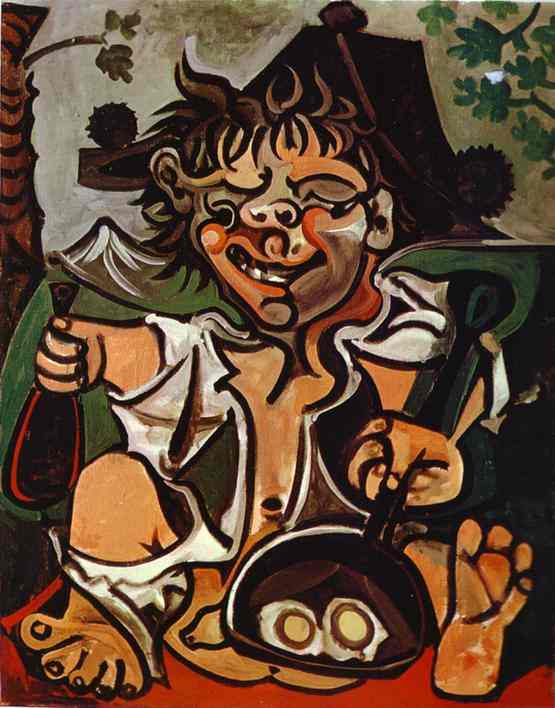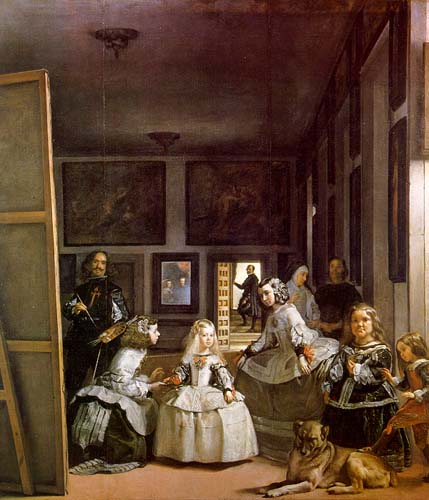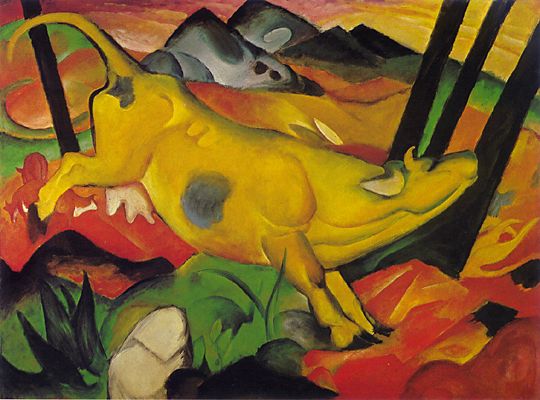'S'OK.

Chinese art baffles me.
Posted on 06/07/2005 12:23:29 AM PDT by nickcarraway
Picasso's paintings have captured the imagination of art lovers the world over but they remain a mystery to many in China, as visitors at an exhibition of his lesser-known works here attest.
Beijing has a lively art scene and its residents pride themselves as the most culturally informed in the country.
But visitors said even they were mystified by the Spanish master's lesser-known collection -- mostly etchings and engravings that are illustrations in books of European classics.
"I don't really understand his works, they are relatively abstract. I think this is because I know too little about his culture and background," said 19-year-old Gong Simiao, an engineering student.
The fame of Picasso has attracted some 100,000 visitors to the exhibition in Beijing but many admitted they know little about his artistic background and that has prevented them from understanding his work.
"He lived in a different era and culture and I have no knowledge of these stories so it's difficult to invoke a response in me," said Sun Miao, 23, who works for a logistics company.
Others said their first sighting of the original works of one of most famous artists in the world was nonetheless an eye-opening experience.
"I've not seen anything quite like this before," said student Niu Liyun, 20, who was admiring the simple lines and curves of Picasso's engravings in Prosper Mirimie's classic, Carmen, published by La Bibliothhque Francaise in 1949.
"They are very vivid and expressive. I especially like the depiction of the facial expressions," she said.
Young people in China, even those who pride themselves as patriots, are curious about and embrace everything Western from Hollywood blockbusters and computer games to art.
"I've always wanted to know more about Western culture, especially in the art field," Gong said.
"I think it's a good thing that these paintings have come to China because young people have so little understanding, and they don't really know what Western culture is really like," she said.
The collection features other works, including Le Tricorne (The Three-Cornered Hat), Picasso's design of sets and costumes for the 1919 Ballets Russes production of the ballet, and La Tauromaquia (The Bullfighter), 26 aquatint etchings illustrating the art of bullfighting completed in 1957.
Some visitors expressed disappointment that what was touted as Picasso's largest exhibition in Asia displayed none of his more colourful and famed masterpieces such as Les Demoiselles d'Avignon.
"This is not his main collection, I'm a bit disappointed," said Liu Xiaoxiao, a 33-year-old civil servant.
Curator Zeng Yi, the organiser of the exhibition, said exorbitant insurance and staging costs has snuffed out any idea of bringing Picasso's best known works to China.
The staging of Picasso's 10 by 16 metre "Parade" -- his largest canvas work completed in 1917 -- in Hong Kong last year cost over 10 million Hong Kong dollars (1.28 million dollars) excluding insurance fees.
Even so, Zeng said he hoped these lesser-known impressionist works could inspire a spirit of innovation and creativity among Chinese art lovers and professionals.
"Through this exhibition I hope more people will understand more about Picasso's personality and his thinking," he said.
The curator said he hoped Chinese artists would dare to do what Picasso did -- to push beyond traditional artistic limits and to experiment with unusual and avant-garde ideas.
"Most Chinese artists focus too much on traditional Chinese paintings, while this is good ... they never try to go one step beyond. They are always imitating other people's styles but art should be about one's own expression and thinking," said Zeng.
But some visitors found Picasso's erotic depiction of women's bodies in his 1968 illustrations for Fernando de Roja's 1499 novel La Cilestine too radical.
"Chinese people are not so expressive about bodies and desire, they don't really accept this side of modern art," said Liu.
Even so, the master's works seem to have the power to push aside cultural differences to reach the hearts of the less-sophisticated ordinary people.
Ling Chunliao, 74, a retired worker, said he came to spend his day at the art gallery with no specific aim.
"Picasso? I don't know who he is. I don't know where he is from," said the old man, sporting a blue Mao jacket and hat -- an increasingly rare sight in the Chinese capital nowadays.
Asked what he thought of the exhibition, he said: "It's quite nice I suppose. I like the bullfighting pictures, now I know more about bullfighting, my heart is somewhat fulfilled."
'S'OK.

Chinese art baffles me.



I have a feeling that the Chinese would have appreciated the Parade images (the top ones posted here) better than the Demoiselles D'Avignon anyway. The latter is a huge painting and I don't think it travels much from NYC's Museum of Modern Art.
But I think it's a great idea to expose the Chinese to western abstraction. Even Pollock's drip works were triumphed by the US after WWII as they travelled in Europe, promoting the freedom of American artists (vs. the strangulation of Russian art under Communism).
Art ping.
Let me know if you want on or off this list.







I agree,
I feel Picasso is an aquired taste---
Like Sushi, dipping snuff and performance art ;)
OK, so I do like Guernica and his daughter's perfume, but that's about it. 'sides, he was really, really rotten to the women in his life.

You will probably like the work of Rosa Bonheur. It is interesting what happened to all academic art in the 1970s. Because the feminists were searching for women artists, when they lauded Rosa Bonheur, they gave credence (and more interest) to academic art (like that of Bougereau) that had previously been ignored. Prices soared for his works (and hers as well).


For my taste (and art is all about different tastes, isn't it?), I love Franz Marc's Blue Horses from 1913. Marc wanted to see harmony between man and nature; he was killed in WWI at Verdun. He seems to capture the essence of horses in their poses, heads down, almost whinying. Sometimes, I think, academic art gets very caught up with each muscle and little detail and, to me, loses some of the heart.


I LOVE PICASSO!!!
Not a big fan of the Blue Period - but really enjoyed his sculpture and his love of the female form.
His sketches really show brilliance with a single line.
I also enjoy the realists, Dagnan-Bouveret and Eakins come to mind. Homer as well.
And especially Anders Zorn, Joaquin Sorolla and John Sargent.
Meanwhile, I was looking at a book of Velasquez paintings this morning - I was shocked - he might be my favorite painter for the time being.

Some things by Picasso I appreciate, but I have yet to learn to understand why he occupies the place in art that he does.
Now those are great paintings and works of art. Thanks for posting them!
Ooh. I like that Blue Horses painting. Very nice.
I can't find an example of "The Drinkers" by Velasquez that allows me to hotlink. The one I attempted to link can be seen here:
http://www.artrenewal.org/images/artists/v/Velasquez/large/Los_Borrachos_The_Triumph_of_Bacchus.jpg
Yes, I agree that "Nymphs and Satyrs" is sexy. The Picasso might be also, except that it's more an idea than an image.
There is one thing about Bouguereau that really gets to me - as a father who raised a female to adulthood, and who has been lucky enough to have the wonderful father/daughter relationship that sometimes occurs, his "peasant girl" paintings truly speak to me. I've never seen an artist capture the young girl as he did.
That didn't work either, I give up.
My little girl is still little; maybe I'll like those Bouguereau works more as she grows up.
Velazquez is awesome, and he inspired Manet and the brushwork of many others. Velazquez seems so realistic, but up close it is again just a jumble of brushwork (like Homer, discussed in a previous thread). Let me try for a Velazquez image.


Notice the detail: the corsage, dress, etc. They are not nearly as detailed as you might expect. A few slashes of the brush make a corsage that appears detailed from a distance.
This work by Velazquez is called Las Meninas (Maids of Honor) done in the mid-17th century. The questions to ask are: what is he painting, who are the people in the mirror, and what's going on? It is a self-portrait of the artist, and it is huge (about life-size), shown in the Prado, which I am dying to visit.
Marc has some wonderful images, especially of animals. I'm so glad you liked that one. If you can ever get to the Guggenheim Museum in NYC, they have some of these by Marc.


First one is Marc's Yellow Cow, second one is Stables c. 1913, influenced by Cubism, but a colorful one at that. It's a shame he was killed in WWI; I would have loved his later work.
I like that one too...now I am motivated to hit Prado too...thanks for the close ups. I knew that was the artist on the left, but hadn't realized it was life sized, which makes the painting upwards of 12 feet tall!
Do you have any links to those guys in the forge, or the drunkards?
Disclaimer: Opinions posted on Free Republic are those of the individual posters and do not necessarily represent the opinion of Free Republic or its management. All materials posted herein are protected by copyright law and the exemption for fair use of copyrighted works.